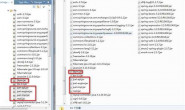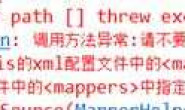|
在form表单做上传,用servlet技术,当有表单属性enctype=”multipart/form-data” ,servlet端request.getParameter(”username”)得不到属性的值,该如何解决,没用struts的上传 |
|
 |
使用外部jar包吧。org.apache.commons.fileupload这个可以 自己查下资料
|
 |
不会吧,换个名字试试
|
 |
不会吧,你换个名字试试,肯定是你的页面问题
|
 33分 |
List fileItems = upload.parseRequest(request);
Iterator iter = fileItems.iterator(); while (iter.hasNext()) { FileItem item = (FileItem) iter.next(); item.getInputStream(); if (!item.isFormField()) { //文件流 }else{ //非文件流 String value=item.getString(); value = new String(value.getBytes(“ISO-8859-1″),”UTF-8”); } |
 5分 |
+1这时编码变了,直接通过request去获取参数是得不到的。
|
 |
原因是你的form里封装的是二进制数据,需要特殊处理,
这样确实有点麻烦,你最好是把文件上传的form和常规数据的form分开提交, |
 |
网上搜下 FileItemFactory factory = new DiskFileItemFactory();
|
 |
因如果增加了enctype=”multipart/form-data”,那么提交的表单就不能再用普通的方式取得了。
而且比如Tomcat的Servlet标准实现里也没有对于这样二进制数据的获取实现,所以你得自己解析了。 有很多开源的上传文件的jar包可以用,你搜一下就有了。我这里提供一个实现你参考一下。
public class FileFormAnalysis implements FormAnalysis {
private static final LogUtil LOG = new LogUtil(LogFactory.getLog(
FileFormAnalysis.class));
/**
* 获取上传各文件文件名所在域的字节数组的迭代器
* @param request 请求
* @return 字节数组的迭代器
* @throws IOException
*/
@Override
public Iterator<Field> analysis(HttpServletRequest request)
throws IOException {
InputStream input = request.getInputStream();
//没有设定文件字符集的话,默认是""iso8859_1""
String charset = UploadBytes.getCharset(request);
//获取表单域的分隔符
byte[] boundarys = UploadBytes.getBoundaryStr(request).getBytes(charset);
return new FieldIterator(input, charset, boundarys);
}
/**
* 获取上传文件迭代器的实现
*/
private class FieldIterator implements Iterator<Field> {
private String charset;
private byte[] boundarys;
private InputStream input;
private ByteArrayOutputStream output;
private Field currentField;
private List<Field> currentNextFields;
int num = 0;
private FieldIterator(InputStream input, String charset,
byte[] boundarys) {
this.input = input;
this.charset = charset;
this.boundarys = boundarys;
this.output = new ByteArrayOutputStream();
}
@Override
public boolean hasNext() {
currentField = null;//初始当前域置为空
//如果一次取得域有多个
if (currentNextFields != null && !currentNextFields.isEmpty()) {
currentField = currentNextFields.remove(0);
return true;
}
int r = -1;
byte[] buff = new byte[1024];
List<byte[]> fieldList = null;
List<byte[]> fileList = null;
try {
while ((r = input.read(buff)) != -1) {
output.write(buff, 0, r);
//获取上传文件的各域的字节列表
fieldList = UploadBytes.findFiled(boundarys, output);
if (fieldList != null && !fieldList.isEmpty()) {
//获取实际上传文件字节列表
fileList = UploadBytes.getFilesByteList(fieldList,
charset);
if (fileList != null && !fileList.isEmpty()) {
break;
}
}
}
if (fileList == null || fileList.isEmpty()) {
return false;
}
if (fileList.size() > 1) {//如果该长度范围有多个域时
currentNextFields = new ArrayList<Field>(fileList.size());
}
Field field = null;
for (int i = 0; i < fileList.size(); i++) {
//获取上传文件的实际内容的Field对象
field = UploadBytes.getField(fileList.get(i), charset);
if (i == 0) {//该范围长度有一个域的情况
currentField = field;
} else {//如果该长度范围有多个域的情况
currentNextFields.add(field);
}
}
} catch (Exception ex) {
LOG.errorLog(ex);
return false;
}
return currentField == null ? false : true;
}
@Override
public Field next() {
return this.currentField;
}
@Override
public void remove() {
throw new UnsupportedOperationException();
}
}
}
至于原理嘛,简单的说下。 <form enctype="multipart/form-data" action="etnetChina/etnetUpload" method="post"> <input type="file" name="file"/> <input type="text" name="text" /> <input type="submit" value="上传文件" /> </form> 上面是一个表单,同样multipart/form-data。 text This upload test. 所以提交的http请求大概是这样的。 POST /Upload HTTP/1.1 Host: localhost:8080 User-Agent: Mozilla/5.0 (X11; U; Linux i686; zh-CN; rv:1.9.2.8) Gecko/20100723 Ubuntu/10.04 (lucid) Firefox/3.6.8 Accept: text/html,application/xhtml+xml,application/xml;q=0.9,*/*;q=0.8 Accept-Language: zh-cn,zh;q=0.5 Accept-Encoding: gzip,deflate Accept-Charset: GB2312,utf-8;q=0.7,*;q=0.7 Keep-Alive: 115 Connection: keep-alive Content-Type: multipart/form-data; boundary=---------------------------205147955511612195381301874305 Content-Length: 243 -----------------------------205147955511612195381301874305 Content-Disposition: form-data; name="file"; filename="test.txt" Content-Type: text/plain [\r\n] text This upload test. -----------------------------205147955511612195381301874305 Content-Disposition: form-data; name="text" [\r\n] test -----------------------------205147955511612195381301874305-- [\r\n] 上面的代码就是解析这些东东。其中 简单就是这些。 |
 |
response.setCharacterEncoding(“UTF-8”);
request.setCharacterEncoding(“UTF-8”); DiskFileItemFactory factory = new DiskFileItemFactory(); ServletFileUpload upload = new ServletFileUpload(factory); upload.setHeaderEncoding(“UTF-8”); List items = null; items = upload.parseRequest(request); Iterator itrTwo = items.iterator(); String path = “”; while(itrTwo.hasNext()){ FileItem item = (FileItem) itr.next(); if(item.isFormField()){ if(item.getFieldName().equals(“path”)){ path = new String(item.getString().getBytes(“iso8859-1″),”utf-8”);; break; } } } 摘了一部分 |
 |
ommons.fileupload,smartload都试了,还是解决不了,难道只能用框架(比如struts的上传)上传吗?
|
 2分 |
+1 , 因为你设置了表达是文件流形式提交的,request获取不到值
|
 |
解决了 谢谢大家
|
 |
说原理的不得分,直接给个能用的就行了。。。。原来如此。
|
 |
List fileItems = upload.parseRequest(request); 中的upload是什么? |
 |
//如果用的是smartupload的话
SmartUpload mySmartUpload=new SmartUpload(); |
 |
问题好棒,正好遇到了这个问题!
|




